British East India Co. a power unto itself
By George Manz | Monday, 1 July 2002
You've probably heard about the Boston Tea Party, the Opium Wars with China and Napoleon's exile to the remote island of St. Helena. But did you know that ll these major world events, and many more, occurred because of the East India Company?
It all started Dec. 31, 1600, when Queen Elizabeth I signed a Royal Charter legalizing the existence of the Governor and Company of Merchants of London trading into the East Indies.
This granting of a monopoly on all English trade to the east of the Cape of Good Hope heralded the true beginning of English imperialism. The original 218 East India Company (EIC) investors included the Lord Mayor and seven aldermen of London, several knights and a large number of merchants and tradesmen. In order to finance the company, the investors raised £68,37 between them.
The First Voyage
In his book, The East India Company: Trade and Conquest from 1600, Antony Wild notes the first voyage set sail in February 1601. It consisted of four ships, with Capt. James Lancaster aboard the flagship Dragon. On board the four ships were £28,472 in bullion, as well as £6,860 worth of goods to trade during the voyage.
Wild writes that things didn't go as smoothly as hoped – many of the sailors aboard three of the ships lost their teeth from scurvy by the time the ships arrived at Table Bay near Capetown. Lancaster's crewmen did not because he stocked lemons on board. But some of the sailors didn't just lose their teeth – Wild notes that more than 100 died during the voyage.
After a brief stopover to resupply their provisions and recuperate, the ships set sail from Table Bay for the long journey east. Their goal was to trade their bullion and goods for spices from the fabled Spice Islands. But the Company men were disappointed when they arrived in Aceh in June 1602, in what is now Indonesia.
Lancaster soon found out that the Dutch had a monopoly on trade in the islands and no one would trade with him. He also learned that the source of the sought-after spices were farther down the coast. So Lancaster, using cutlass, musket and cannon, engaged in piracy, boarding a Portuguese ship and making off with a large cargo of pepper and Indian fabrics.
Lancaster's next stop was a small town called Bantam, where the Dutch and all the countries in the South China Sea traded. Wild chronicles the EIC's first trading factory at Bantam as a combination of fort and warehouse where Lancaster could sell the purloined cottons.
Wild comments on Lancaster's success on the first voyage:
Having filled his holds with pepper, identified a source of further supplies, established a factory at Bantam and learnt the value of the piece trade, Lancaster's command of the First Voyage of the East India Company could be judged a success.
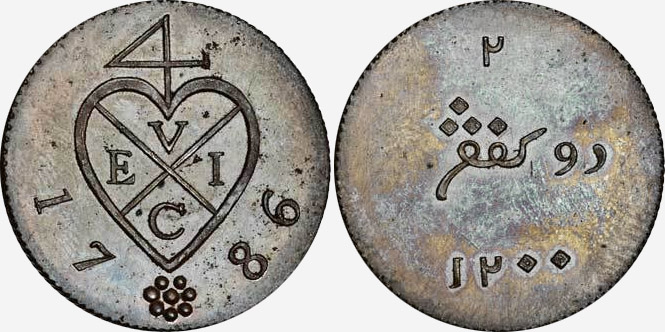
This 1786 two-keping was minted at the Soho Manufactory for the East India Company for use at Bencoolen, located on the southern coast of Sumatra.
When Lancaster and his motley crew arrived back in England, they came back to a new country. Queen Elizabeth I died in 1603 without an heir, so King James of Scotland, the son of Mary, Queen of Scots, succeeded Elizabeth. This united England and Scotland for the first time ever, and the new united country became known as Great Britain.
James I knighted Lancaster for his accomplishments. But the 500 tons of pepper in his ships was almost worthless because the King's Navy had just captured another ship full of pepper. Wild recounts the result:
the London market was glutted and the price fell dramatically – as did the return for the investors, who had to make do with sacks of pepper instead of cash.
J.R.S. Whiting, in his excellent book, British Trade Tokens: A Social and Economic History, humorously notes the:
first voyage brought 1 million pounds of pepper to England. The company had been anxious not to lose a pinch of it, so they had issued their stevedores with special overalls lacking pockets, but they need not have worried, for it was to take them eight years to sell the cargo.
While the first voyage was not as successful as the investors would have liked, many did not lose confidence in their new enterprise.
Coffee, Spices and Textiles
Future voyages were sent to the far reaches of the known and unknown world. One of these voyages traveled to Mocha, near the southern end of the Red Sea in what is now Yemen. There they learned of a bean, which when roasted, ground and steeped in hot water, produced a flavorful beverage. By 19660, the Company imported large quantities of coffee to Britain.
The Company soon began to trade in different goods that could be sold at a profit. Textiles from India were often sold in other parts of Asian, as well as Europe and even North America. The trade in textiles (knowns as th piece trade) was so profitable the EIC began to set up factories in several of India's textile-producing areas. The Company set up factories at Masulipatnam on India's east coast and at Surat on the west coast, followed soon after by more.
Wild describes the vital importance that the textile trade had on the Company:
They soon found that the quality of the cloth they were able to buy was not only suitable for trade in Java and Sumatra, but could find a ready market at home. The piece trade was not the spice trade, but at least it was merchandise which could justify the risk and expense of the Company's Voyages. Without this piece trade, the Company could have faced disaster in the early years; whilst the Company's long-held dream of exporting fine woollen English broadcloth to the East was never realised, it was as cloth merchants that they survived.
But the EIC was not willing to let the Dutch have complete control over the spice trade. One day in 1616, a Company ship bumped into the small volcanic island of Pulo Run, in the far flung Banda Islands of present day Indonesia. While all of other islands in the area were controlled by the Dutch, this enclave, only two miles long by half a mile wide, with its small nutmeg production, became an important outpost not only for the EIC, but Britain as well.
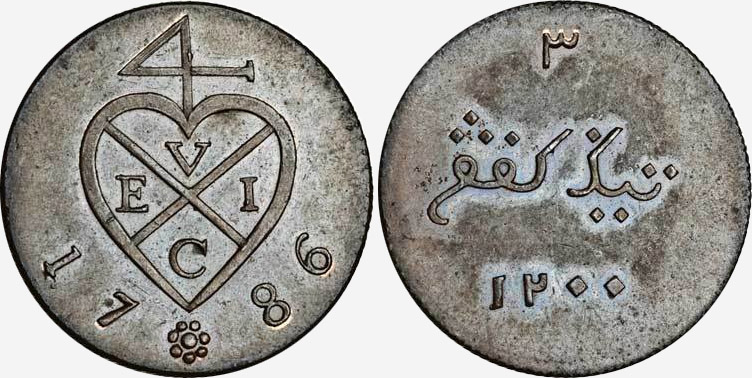
Another East India coin from 1786 for use at Bencoolen, this time a 3-keping. The kepings were the first coins made by Matthew Boulton's Soho Mint in England.
The local inhabitants swore allegiance to King James and such was the attachment felt by the British for this musket-shot wide outpost of Empire that James I even styled himself King of England, Scotland, Irland and Rulo Run.
John Keay, in his book The Honourable Company: A History of the East India Company, reveals the immense profitability associated with the nutmeg trade from this peck of land.
Nowhere else on the globe did the trees flourish and so nowhere else was their fruit so cheap. [...] ten pounds of nutmeg cost less than half a penny and ten pounds of mace less than five pence. Yet in Europe the same quantities could be sold respectively £1.60 and £16, a tidy appreciation of approximately 32,000 percent.
But he Company wasn't able to keep the volcanic island for long because the Dutch soon occupied it. And by a twist of fate you will soon see the importance of Pulo Run in the future of the history of the world.
The Tea Trade
In the 1600s, tea wasn't a common drink in Britain. But that would change when the Portuguese, who had established a trading post at Macao on the coast of China, began drinking tea. Soon after King Charles II was restored tot he British throne in 1660, he decided to marry. His choice was a Portuguese princess by the name of Catherine of Braganza, whom he married in 1662. Soon drinking tea became a national past time in Britain.
Wild notes that by 1687, the EIC placed an order for 20,000 pounds of tea. he goes on to write that in 1750, the nation was importing two and a half million pounds of tea a year and that by 1800, the Company was importing 20 million pounds. The Company's investors made huge amounts of money from the tea trade.
When Charles II married Catherine of Branganza, she came with a dowry that included the island of Bombay, India. Since the King had no use for the city, he leased it to the EIC in 1668 for £10 a year. Meanwhile, the many wars over trade between Britain and Holland had been going on for decades. Most of the wars ended after the Treaty of Breda in 1667. Many colonies switched hands. England not only gave up control of Acadia to the French, but also rendered Suriname and Pulo Run to the Dutch. In exchange, Holland handed over New Amsterdam (now better known as the island of Manhattan) as well as New Netherland (the Dutch controlled the areas now called New York and New Jersey).
Meanwhile, the many wars over trade between Britain and Holland had been going on for decades. Most of the wars ended after the Treaty of Breda in 1667. Many colonies switched hand. England not only gave up control of Acadia to the French, but also surrendered Suriname and Pulo Run to the Dutch. In exchange, Holland handed over New Amsterdam (now better known as the island of Manhattan) as well as New Netherland (the Dutch controlled the areas now called New York and New Jersey).
It turned out to be the swap of the century: the Big Apple for a little nutmeg.
St. Helena
The small island of St. Helena is located in the middle of the Atlantic Ocean near the Tropic of Capricorn. The nearest island, Ascension Island, is 700 miles away, Angola, the nearest country in Africa is 1,200 miles away, while Brazil is 1,800 miles away. While the island was first discovered by the Portuguese in 1502, it wasn't noticed by English explorers until 1582. But in 1659, Captain John Dutton took control of the island for the EIC.
In 1730, a Company agent in Mocha was authorized to send coffee seeds to St. Helena. The seeds were planted two years later. Since the island's climate is perfect for growing coffee, the coffee crop is considered one of the best in the world and is therefore quite expensive. Quite a number of famous people have visited the island, such as the famous English astronomer Edmund Halley.
But two other quests on the island have played an important role in the history of Europe. The first to visit St. Helena was Arthur Wellesley, the future Duke of Wellington, on a stop-over from his battles in India. Wellesley is reported to have spent the night at a guest house in the capital, Jamestown. One year later, after Wellesley defeated Napoleon Bonaparte at Waterloo, Napoleon was exiled to St. Helena, where he slept in the same room Wellesley had slept. Upon hearing the two men had slept in the same bed, Wellesley wrote a letter from Paris to Admiral Malcolm on St. Helena.
You may tell Bony that I find his apartments at the Elyse Bourbon very convenient, and that I hope he likes mine (in St. Helena) ... it is a droll sequel: enough to the affairs of Europe that we should change places of residence.
Because life on the island for the former Emperor was not to his liking, Napoleon once said The only good thing about St. Helena is the coffee. Napoleon died in exile in 1821.
At War in Indian
The Company soon had the three most important Indian cities under its control: Bombay, Madras and Calcutta. Each area became known as a Presidency, each with its own governor. These Presidencies were completely under EIC control. But the Company devised another method of administration in its attempts to annex the entire subcontinent. The method used local rulers who were subject to Company control.
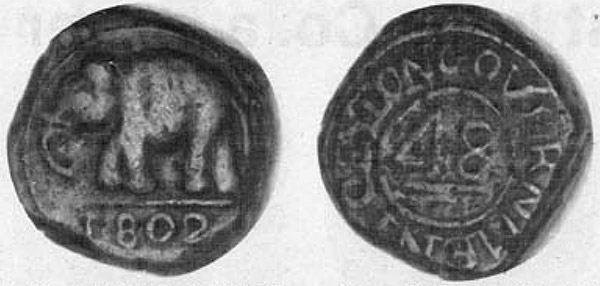
A stuiver minted for the East India Company for use in Ceylon (now Sri Lanka) was based on the prior Dutch rixdollar. Forty-eight suivers equaled one rixdollar.
Yet other Indian rulers defied EIC control of their territories. One of the most famous was Siraj-ud-daulah, who shortly after he became the Nawab of Bengal, attacked the EIC's fortifications at Calcutta in 1756. After he captured the city, he was implicated in the infamous Black Hole of Calcutta, in which 146 English prisoners were said to have been imprisoned in the tiny and airless dungeon at Fort William. When the doors were finally opened, 123 of the prisoners were said to have died.
Although we may never know how many died in the prison that day, the Black Hole of Calcutta was used as a pretext to demonize the Nawab and by extension, the Indian people. This embellished account was taught in schools throughout the British Empire. But the East India Company was not about to let the Nawab get away with challenging their rule. in 1757, the Company's forces, led by the General Robert Clive (a former Company clerk), defeated the Nawab's army at the Battle of Plassey.
It wasn't much of a battle because Clive had bribed the Nawab's former finance minister to throw his lot in with the British. Thousands of the Nawab's troops threw away their weapons, deserted, or surrendered. Others turned their weapons against the Nawab's remaining troops. During the 1840s and 1850s, large tracts of land were absorbed into the EIC's growing empire. one of the methods utilized was the Company's Doctrine of Lapse of 1848, an agreement between the EIC and local rulers that stated that if the ruler did not have a son to inherit his kingdom, then the kingdom would immediately be transferred tot he EIC. This method of grabbing land was despised by many Indian people.
The East India Company ruled India with absolute authority. They accomplished that authority through their private Army, which, at its height, consisted of 250,000 men, the majority of them Indian soldiers. Some Indian rulers rebelled against the Company's annexation schemes, but were defeated.
The Indian Mutiny
The next major event occurred in 1857. Indians call it the First War of Independence, while the British call it the Indian Mutiny. This was, a defining moment in Indian history, was a direct result of the Company's political and economic policies. In the spring of 1857, Indian troops began to mutiny across northern and central Indian against European control. But the Indian troops were soon defeated, with horrible consequences for some. Commander William Hodson, when he looted Delhi, committed numerous atrocities. not only did he shoot the Emperor's two sons and one grandson in cold blood, but worse was yet to come for civilians in the city.
Wild's book gives us a glimpse into what befell the people of Delhi. in Hodson's words:
All the people of the city found within the walls when our troops entered were bayoneted on the spot ... These were not mutineers, but residents of the city who trusted to our well-known mild rule of pardon. I am glad to say they were disappointed.
Although the Company may have won the battle, it lost the war over its control of the Indian subcontinent. In 1858, the British Parliament passed the India Bill, which gave complete control of the Company's holdings in Indian to Britain. The Indian Bill, Wild says, vested the:
Company's remaining armies, batteries, churches, colleges, debts, desks, elephants, godowns, graves, juges, lascards, navies, paintings, papers, pensioners, powers, treaties, territories, vassals, vessels, warehouses and whorehouses in Her Majesty Queen Victoria.
From then on, India became a Crown colony, subject to the governance of the British Parliament.
The Boston Tea Party
But the East India Company didn't just have its finger in the Indian pie. It also had dealings in North America, where it was a major importer of goods. And one of those imports was tea, which many American colonists liked to drink. Because the Company had huge quantities of tea in its warehouses and was facing bankruptcy, the EIC drafted the Tea Act of 1773, which was passed with little discussion in England and with no input from the American colonists.
The object of the Tea Act was to allow the Company to dump its vast quantities of tea into the American colonies at very low prices, as well as providing taxes for the Crown. This threatened the livelihood of many colonial merchants and smugglers who rightly feared the Company would be in a position to undersell them. When the first tea-laden ships arrived at Griffin's Wharf in Boston, they were boarded by American patriots, some with painted faces and dressed like Mohawk Indians. About 150 patriots, including Paul Revere, boarded the three ships, broke open the chests of tea with tomahawks and other implements, and threw the tea into the harbor. The event and subsequent British response helped spark support for the American War of Independence.
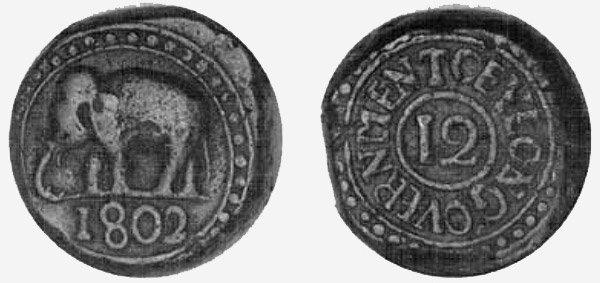
A Ceylon quarter-stuiver worth 1/192 to the rijksadaalder. Ceylon was ceded to the East India COmpany by the Dutch after the Napoleonic Wars.
The Opium Wars
But the Company wasn't only in trouble in America. The EIC needed silver coins so it could purchase tea in China. But how to get the silver? The answer was simple: Sell the opium from the poppies the Company grew in India to the Chinese.
But there was a major problem. The Chinese Emperor had banned opium from China and was not about to allow the Company to change the rules for his people. The Emperor ordered Captain Elliot, Britain's representative in Canton, to burn large quantities of opium. he did so, but there was a dispute over who should pay for the burned drugs. So when the Emperor's governor in Canton demanded further concessions, such as the immediate death penalty for the owner of any ship caught with opium on board, the Company, in defense of free trade sent its Navy to China.
It wasn't much of a battle. Even though the Company sent only 3,000 men and a small number of ships to fight the Chinese EMpire, they won easily. The resulting Treaty of Nanking forced several Chinese cities to open their ports to foreign trade and Hong Kong came under exclusive British control.
Company Ships and The Admiral Gardner
The first ships that the EIC sent on its voyages were leased. The demand for ships increased as international trade spread, increasing the prices paid for ships. So in 1607, the Company began building its own vessels at a far lower cost than if they purchased them from private ship-builders. By the 1640s, the Company could boast that it had the largest private fleet in Britain.
The Company's ships included the tea clippers like the Cutty Sark, which is now on display near London. Another ship, though less well known, is of particular interest to coin collectors because it carried a huge number of EIC coins bound for India. We begin the story in 1796, when the Admiral Gardner, weighing more than 800 tons, was built on the River Thames. The three-deck, 145-foot ship was named after Alan Gardner, a distinguished naval officer and by 1796, a Member of Parliament.
On its sixth and final voyage in January 1809, the Admiral Gardner was commanded by William John Eastfield. On Jan. 25, 1809 the Admiral Gardner and its sister ship Britannia encountered a violent gale in the Strait of Dover, just off the southeast coast of England. The tremendous force of the storm forced the two ships onto the Goodwin Sands, a treacherous bank of sandbars nicknamed the ship-swallower. Both ships sank with their cargoes and several crew members perished.
Among the cargo on board the Admiral Gardner were millions of 10-cash copper coins, made for the Company for use in the Presidency of Madras. The word cash is derived from the Tamil word kasu, which means a coin. The coins were minted in 1808 and 1809 at the famous Soho Mint in Birmingham, founded by Matthew Boulton and his partner James Watt.
The obverse of the 10-cash coin bears the coat of arms of the East India Company, with the date, 1808, below. Between the date and the coat of arms, the Latin inscription reads Under the Patronage of the King and Parliament of England. The reverse inscription is in Urdu, the local language of many of the people in Madras. It reads Ten Cash are equal to Two Falus. Below the Urdu inscription are the words X. CASH. The 10-cash coins, weighing 72 to the pound, were packed by the thousands in wooden barrels. The coins were to be used to pay the Company's workers in India and were valid in Company stores.
When a group of divers succeeded in salvaging the wreck in the 1980s, they recovered a large quantity of the coins, including an intact barrel full of coins. Many of these coins are now in collections around the globe.
The Admiral Gardner Token
According to R.C. Bell's book, Political and Commemorative Pieces Simulating Tradesmen's Tokens 1770-1802, Alan Gardner, the man the ship was named after, was elected as a Tory Member of Parliament for Plymouth in 1790. By 1793 Gardner was promoted to Rear Admiral. Subsequently he was made a baronet and Major-General of the Marines for his distinguished conduct, Bell writes.
In 1796, Gardner ran in the constituency of Westminster against Liberal Charles James Fox and Radical John Horne Tooke. Gardner used many means to get elected, including having a lection token manufactured to help him get elected. The beautiful token was designed by Wyon and manufactured by Peter Kempson. The penny-sized token dedicated to Gardner is listed in Dalton and Hamer's famous book The Provincial Token-Coinage of the 18th Century under Middlesex 2256 (Political and Social Series). The obverse depicts Admiral Gardner as a naval officer, standing in front of a cannon and trampling on the French flag, with the words ADMIRAL GARDNER WORTHY THE FLEET OR THE SENATE ELECTION TOKEN.
The reverse takes a satirical swipe at Gardner's electoral opponents and their causes. Mike Grogan explains the significance of the Gardner token, his favorite.
Charles James Fox is shown as a fox standing on three unstable stones which are labeled with Liberal causes. The fox holds a banner declaring a Liberal sentiment. [John Horne Tooke] is portrayed as a clergyman (he once studied for the clergy) propping up the stone blocks with a plank of SEDITION (Tooke was tried and acquitted of High Treason in 1794). A stable obelisk declaring Conservative values stands securely to the left. The reverse also states a great 18th-century pun: SOME OF THE FOXES (Fox's) TRICKS (cards) ON A WESTMINSTER POLE (POLL). [Gardner] was made of Irish Lord in 1800 and became Commander of the Channel Fleet in 1807. [Fox] was the main political opposition to William Pitt and the Crown during his long Parliamentary career. He championed the American colonists and the French Revolution, along with other often unpopular Liberal causes. [Tooke,] a prominent political Radical, imprisoned in 1777 for libeling the Royal troops in America and acquitted of High Treason in a famous 1794 trial.
Coinage of the East India Company
The coins of the East India Company were not restricted to those that sank on the Admiral Gardner. To service its farflung empire, the Company issued coinage for its many outposts. We will begin this part of the story with Matthew Boulton's Soho Mint, near Birmingham, England. In my article Britain's Cartwheel Coinage of 1797, I noted that Matthew Boulton and James Watt entered into partnership on May 22, 1775, which eventually led the way to the construction of the famous Soho Mint in 1788 and 1789.
In his book The Soho Mint and the industrialization of Money, Richard Doty, the curator of numismatics for the Smithsonian Institute in Washington, D.C., writes that by the end of 1790, Boulton's Soho Mint...
...had four presses on line – plus a fifth, upon which to make experiments, plus other machinery to produce coinage.
Although it was Boulton's wish that he mint the official coin of the realm, minting British coins would have to wait. Boulton's first copper coinage were one, two and three-keping coins minted for Bencoolen, the East India Company's possession on the southern coast of the island of Sumatra (the largest of the islands that now comprise Indonesia). These coins were minted at the Soho Manufactory in 1786 and 1787, before the Soho Mint was erected.
Doty writes that although the Company originally contacted the Tower Mint to produce the coinage for bencoolen, the Company nabobs decided to have the keping coinage produced by a gentleman named Matthew Boulton. Doty acknowledges that although Boulton had great difficulty producing the slightly more than 18 tons of copper on schedule, the Company nonetheless gave Boulton a second order. A few years later, according to Doty, the EIC's next coin order to Boulton would dwarf any coin order that Boulton had coined thus far.
This was a request for the East India Company's settlement at Bombay. While the coiner's performance in his maiden attempt had angered some, there were still enough good feelings (and beneficial connections) to accord him another chance. A major Company man named Robert Wissett acted as emissary:on 11 December 1790, he advised Boulton that there was a Bombay coinage for the asking.
According to Doty's book, the original order was small.
Wissett said that only a few tons of coin were wanted. But it soon expanded dramatically, and Wissett was now talking about one hundred tons of coppers for the deserving inhabitants of the Bombay Presidency.
By February 1791, Wissett notified Boulton that the Soho Mint had the contract. By March 1791, the first shipment left Soho for the Company's docks at London, the first leg of their journey across the sea of India as Doty so eloquently puts it.
[The first shipment] consisted of eighty casks of 1/2-pice pieces, struck at forty-seven to the pound. This remittance worked out to nearly a million and a half coins, but it was merely the tip of the iceberg.
Among the other coins produced at Soho for the EIC's Bombay Presidency were 1 pice, half-pice and double pice (also called half-anna) coins. In only nine months, the Soho Mint had manufactured 100 tons of coins (that's more than 17 million coins) for Bombay.
Doty's impeccable research gives the final number of coins produced:
In all, Boulton created 17,241,001 coins for Bombay – 7,903,280 half-pice, 5,472,740 pice, 2,690,351 1-1/2 pice and 1,174,630 double-pice. His success in filling this order sealed his fortunes with the East India Company.
It's important to note that all the Bombay coins were produced on machinery powered by James Watt's newfangled steam engine, which was the starting point for the Industrial Revolution. But the EIC required coinage for other parts of the world, including the Madras Presidency in southeastern India. Two coins were minted: a 1/45 rupee and a 1/96 rupee. What is most interesting about the two coins are the wide raised rims. Doty informs us that...
...coinage would feature the Company's arms on the obverse, its bale mark on the reverse, along with the date. The obverse legend would be partly incused, partly in relief, while that for the reverse would be entirely incused.
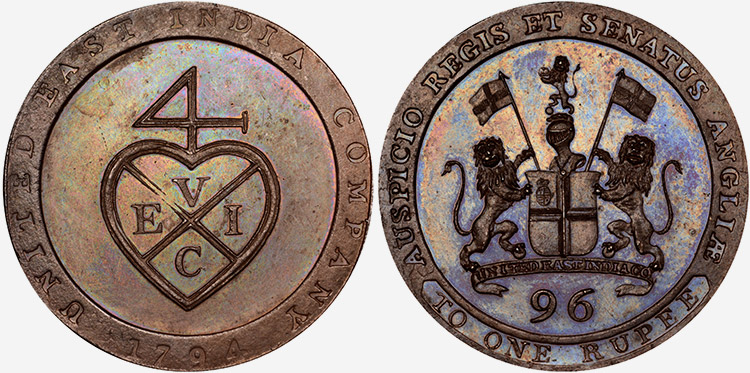
More than 9 million of these 1794 1/96 rupees were produced for use in the Madras presidency in southeastern India.
Both coins were dated 1794 and were made in large numbers: more than 4 million 1/48 rupees and more than 9 million 1/96 rupees. A few years later, Soho produced even more of the partial rupee coins for Madras, this time dated 1797. The next coinage produced for the Company was for Ceylon, which had come into the Company's hands from the Dutch as a result of the first Napoleonic Wars. Doty says the new rulers decided to mint coinage that...
...retained the monetary system of the old, and so they began to think about a coinage based on the stuiver and rijksdaalder of the previous colonizers.
Three different coins were produced beginning in 1802: a stuiver (96 to a rijksadaalder) and a 1/4 stuiver (1/192 to a rijksdaalder). These beautiful coins feature an elephant and the date below on the obverse, while the reverse includes the denomination in the middle of each coin (in the form of the number of coins that would be needed to equal a rijksdaalder) and the words CEYLON GOVERNMENT in a circle around the denomination. The coins are listed KM-73, 74 and 75.
Soho was soon minting additional coins for Madras, this time consisting of 20-cash pieces, 10 cash, 5-cash and even a tiny one-cash coin. The 1-cash is notable because it took 720 of them to equal one pound, and Boulton had to come up with a new method of producing such a minuscule coin. After Matthew Boulton and James Watt died, the Soho Mint was managed by their sons: Matthew Robinson Boulton and James Watt, Jr. And one of the coins they produced at Soho was for the Company's territory of St. Helena where Napoleon had been exiled. Soho produced more than 70,000 half pennies for the island. Doty writes:
Napoleon had inconsiderately died by the time they arrived, and most of the garrison had been or was about to be sent away. The presence of seven hundred thousand coppers on an island with a population reduced to a few hundred was deemed overly generous, and the Company resolved to ship back most of the coinage, so that it could be melted down and used for other purposes.
The half-penny coins featured the Company's coat of arms on the obverse while the reverse includes the date, 1821, in the middle, surrounded by ST HELENA HALFPENNY in a circle surrounded by a wreath. The coins are much sought after for their historical interest and their low mintage. Three different half pennies were produced: the common copper half penny, the scarce proof in bronze and the rare proof in gilt bronze.
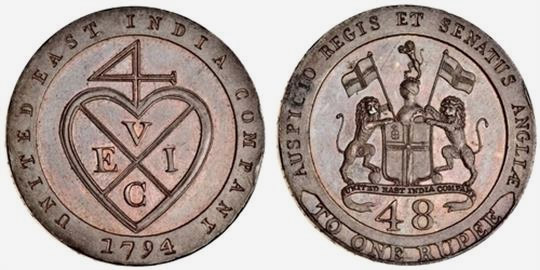
The 1/48 rupee was also produced in 1794, to the tune of more than 4 million. The rupees for the Madras presidency featured wide raised rims.
The Heaton Mint Takes Over
The story of the Heaton Mint and its relationship to the East India Company begins in 1850 when Ralph Heaton II purchased the minting equipment from the now-defunct Soho Mint. The new company was able to procure coinage orders from around the world and one of those orders came from the East India Company.
James O. Sweeny, in his insightful book A Numismatic History of the Birmingham Mint, writes that the last coins bearing the name of the East India Company were all produced at Heaton. These included 1/4 annas dated 1857 and 1858 which were manufactured in large quantities.
EIC Numismatic Complexities
In an attempt to make the complexities of the coinage of the East India Company as simple as possible, I have divided the series of coins minted by and for the EIC in India into several groups. Please note some of the coins issued by the East India Company in India do not fall into any of these very broad categories. One category is all those coins which feature the EIC coat of arms. These were issued for the Presidencies of Bombay, Calcutta and Madras as well as what is commonly called British India.
During the reign of William IV, the Company began a national coinage. This second category, issued in 1835, bears the standard portrait of William IV facing right on the obverse along with the legend WILLIAM IIII KING. The reverse has the denomination in the center of the design, surrounded by a wreath. Outside the wreath are the words EAST INDIA COMPANY and the date below. This category also includes coins issued for Queen Victoria in 1840, which bear the portrait of the young monarch facing left along with the words VICTORIA QUEEN on the obverse. The reverse are the same as those issued for William IV except for the date.
But the Company didn't just issue silver and copper or bronze coins – it also issued some magnificent gold coins as well. Among them are 1- and 2-mohur gold coins that feature the king or queen and their titles, plus the date on the obverse. But what is truly outstanding are the reverses, which feature a majestic lion in front of a palm tree. The Company's name also appears along with the denomination.
A third category of coins issued under the name of the East India Company are those which are modeled after the coins issued by Mogul emperors. These often feature Indian legends in various languages such as Persian and Bengali. Since the number of Indian coins falling into this category includes a huge number of copper, silver and gold coins, I will illustrate this category with the following example. A gold mohur was issued in 1825 at Bombay in the name of Shah Alam II, who ruled from 1759 until 1806. Burton Hobson, in his book Historic Gold Coins of the World, reveals that the coin imitates earlier issues of Surat, a town north of Bombay gained a foothold on the Indian subcontinent.
Its Company origin is revealed, however, by the small crown mint mark on the obverse in the middle of the Persian inscriptions.
While the complete history and coinage of the East India Company cannot be accomplished in this article, I hope this brief history will help enlighten coin collectors around the globe to collect this fascinating coinage.


